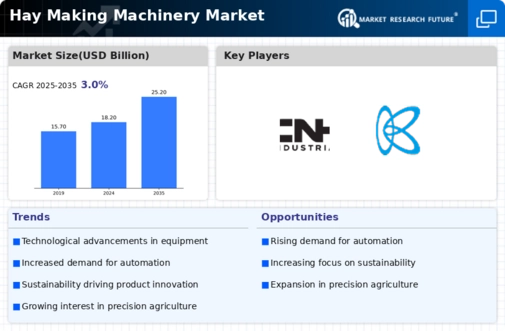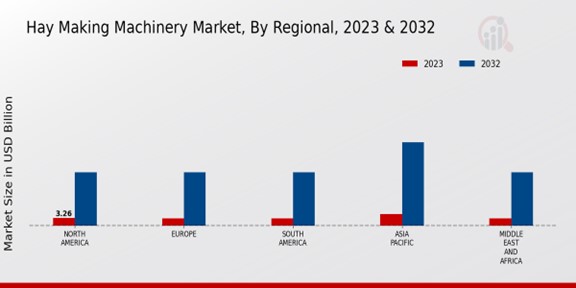Market Growth Projections
The Global Hay Making Machinery Market Industry is projected to experience substantial growth in the coming years. With a market value of 18.2 USD Billion in 2024, it is anticipated to reach 25.2 USD Billion by 2035. This growth trajectory indicates a robust demand for hay making equipment, driven by factors such as technological advancements and increasing forage production needs. The expected CAGR of 2.98% from 2025 to 2035 suggests a steady expansion of the market, reflecting the ongoing evolution of agricultural practices and the necessity for efficient machinery in hay production.
Government Support and Subsidies
Government initiatives play a crucial role in shaping the Global Hay Making Machinery Market Industry. Various countries are implementing policies and providing subsidies to promote the adoption of modern agricultural machinery. These efforts aim to enhance food security and support farmers in improving productivity. For example, financial assistance programs encourage the purchase of advanced hay making equipment, thereby stimulating market growth. Such government support is particularly vital in developing regions, where access to modern machinery can significantly impact agricultural output. As these initiatives continue, they are expected to bolster the market, contributing to a projected CAGR of 2.98% from 2025 to 2035.
Increasing Demand for Forage Production
The Global Hay Making Machinery Market Industry is experiencing heightened demand for forage production, driven by the growing livestock sector. As the global population increases, the need for efficient animal feed becomes paramount. In 2024, the market is projected to reach 18.2 USD Billion, reflecting the urgency for advanced hay making solutions. Farmers are increasingly adopting modern machinery to enhance productivity and reduce labor costs. This trend is likely to continue, as the livestock industry expands, necessitating improved forage management practices. The integration of technology in hay making processes is expected to further support this demand.
Technological Advancements in Machinery
Technological innovations are significantly influencing the Global Hay Making Machinery Market Industry. The introduction of automated and precision farming equipment enhances efficiency and reduces operational costs. For instance, advancements in GPS technology and data analytics allow farmers to optimize hay production processes. These innovations not only improve yield but also contribute to sustainable farming practices. As the market evolves, machinery that incorporates smart technology is likely to gain traction, appealing to a tech-savvy agricultural workforce. This shift towards modern machinery is expected to drive market growth, with projections indicating a market size of 25.2 USD Billion by 2035.
Growing Awareness of Sustainable Practices
The Global Hay Making Machinery Market Industry is witnessing a shift towards sustainable agricultural practices. Farmers are increasingly aware of the environmental impact of traditional farming methods and are seeking machinery that promotes sustainability. This includes equipment designed for minimal soil disturbance and efficient resource use. The adoption of such practices not only benefits the environment but also enhances the long-term viability of farming operations. As consumers demand more sustainably produced food, the market for eco-friendly hay making machinery is likely to expand. This trend aligns with broader agricultural goals of reducing carbon footprints and promoting biodiversity.
Rising Labor Costs and Workforce Challenges
The Global Hay Making Machinery Market Industry is significantly influenced by rising labor costs and workforce challenges. As labor becomes increasingly expensive and harder to find, farmers are compelled to invest in machinery that can automate hay production processes. This shift towards mechanization is not only a response to economic pressures but also a strategic move to enhance operational efficiency. By reducing reliance on manual labor, farmers can maintain productivity levels while managing costs. The ongoing trend of labor shortages in agriculture is expected to further accelerate the adoption of hay making machinery, thereby driving market growth.














Leave a Comment